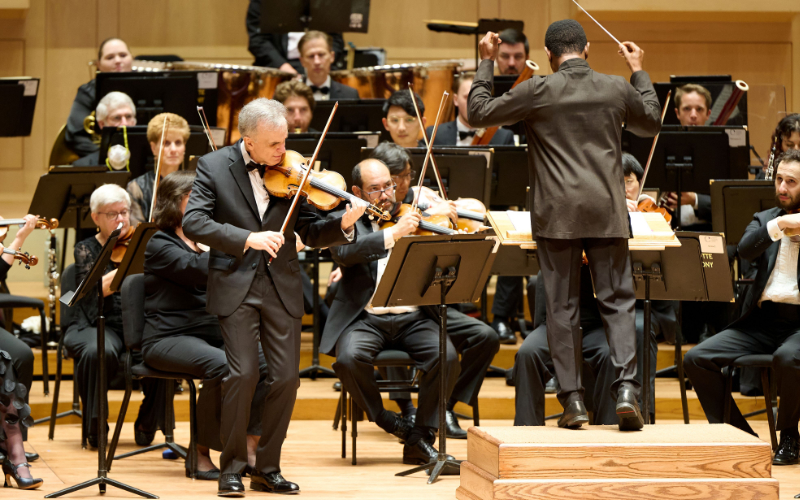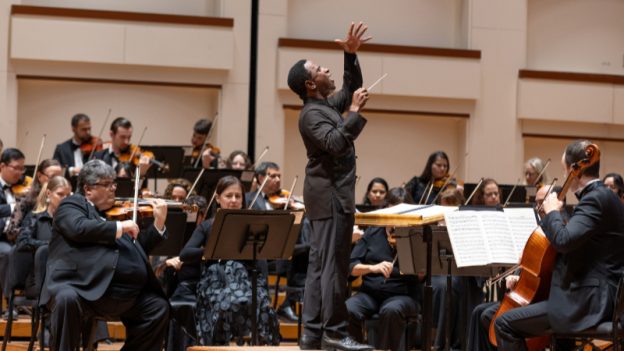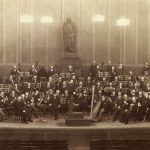September 18, 2025
Belk Theater
Charlotte, North Carolina – USA
Charlotte Symphony Orchestra; Kwamé Ryan, conductor; Gil Shaham, violin.
TCHAIKOVSKY: Symphony No. 1
TCHAIKOVSKY: Violin Concerto
Paul Hyde | 11 OCT 2025
In these discordant days in our public life, what a pleasure it is, a blessing even, to return to the concert hall for an evening of rapturous music-making.
The Charlotte Symphony’s all-Tchaikovsky program on September 18 featured the extraordinary violinist Gil Shaham, who delivered a stunning account of the Russian composer’s ever-popular Violin Concerto.
Shaham’s technique is a marvel. In the thrilling performance at Charlotte’s Belk Theater, the violinist negotiated the concerto with chiseled clarity and precision, with no sacrifice of heart-on-the-sleeve romanticism. Kwamé Ryan, the Charlotte Symphony’s music director, led the orchestra in a supportive, cohesive fashion.
From the beginning, Shaham brought an impeccable tone and articulation par excellence to the concerto. Shaham dazzled in the virtuosic episodes of the long first movement, following that up with a tender and rhapsodic account of the second movement. He coaxed a big sound out of the lower range of his Stradivarius without any hint of harshness.
The violinist also brought the welcome element of surprise to the slow movement by playing some passages with gentle and uncommon quietude. It’s always pleasing to hear a sensitive new take on a familiar classic.
Then it was off to the races for the famously exuberant finale, which Shaham took at breakneck speed while still maintaining the crisp clarity that characterized the earlier movements.

Gil Shaham solos in Tchaikovsky’s ‘Violin Concerto’ with Kwamé Ryan and the Charlotte Symphony Orchestra at the Belk Theater (credit: Genesis Photography)
For an encore, Shaham chose, by sharp contrast, a piece he often plays, the Gavotte en Rondeau, the third movement of Johann Sebastian Bach’s Partita for Solo Violin No. 3 in E Major. It was cleanly and delightfully rendered by Shaham.
Shaham has an almost modest stage presence. Throughout the concert, he stood not out front but quite close to the orchestra, seemingly only inches from the first violinists, with his face turned to his left side in deep concentration. When he moved, it was only to stand inches from Ryan’s left side. In the orchestral interludes, however, Shaham boasted a beaming smile. His enthusiasm was contagious.
Under Ryan’s direction, the orchestra was an ideal partner in the performance, never overshadowing the soloist but shining brightly in the big orchestral moments, such as the majestic main theme of the first movement. This was a gala concert, and sometimes such occasions with a world-class soloist don’t allow for much rehearsal time, but the orchestra sounded thoroughly polished.
A historical footnote: The first performance of Tchaikovsky’s Violin Concerto in 1881 received an infamously scorching review from the influential critic Eduard Hanslick. Read today, the review seems uproarious in its hyperventilating negativity: “For a while, the concerto has proportion, is musical, and is not without genius, but soon savagery gains the upper hand and lords it to the end of the first movement,” Hanslick wrote. “The violin is no longer played: it is yanked about, it is torn asunder, it is beaten black and blue. The finale puts us in the midst of the brutal and wretched jollity of a Russian holiday festival. We see wild and vulgar faces, we hear curses, we smell bad brandy.”
Hanslick’s colorful criticism — bad brandy indeed! — has not aged well. The Viennese critic was reacting to a concerto that was strikingly new and very Russian. Few concerto movements are more thrilling than the finale that Hanslick dismissed as “brutal and wretched jollity.” The raw and rustic energy of the concerto, which Hanslick despised, is the very reason audiences have loved it for almost 150 years.
Ryan opened the concert with an accomplished performance of Tchaikovsky’s First Symphony, subtitled Winter Dreams. Ryan drew robust and yet refined playing from the orchestra. Particularly notable was the burnished string playing throughout the symphony, especially in the second and third movements. The second movement also spotlighted eloquent solos by oboist Timothy Swanson and flutist Victor Wang. With Ryan’s brisk tempos in the finale, the orchestra, powered by timpani and brass, sped the work toward a triumphant conclusion.
In a word, the performance was splendid. The Belk Theater for this world-class concert seemed to be about three-fourths full at most. I wonder sometimes if Charlotte residents know what a treasure they have in their orchestra.
As a sidenote, the orchestra provided an excellent printed program for the concert. The orchestra has favored an online program for recent concerts, but here’s hoping the orchestra will return to printed programs worthy of this fine ensemble. ■
EXTERNAL LINKS:
- Charlotte Symphony Orchestra: charlottesymphony.org
- Gil Shaham: gilshaham.com
- Kwamé Ryan: kwameryan.com

Read more by Paul Hyde.







.png)